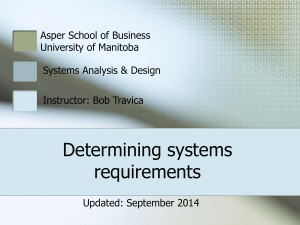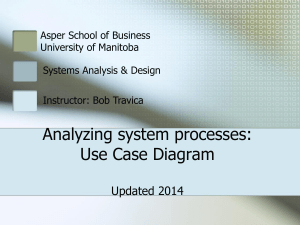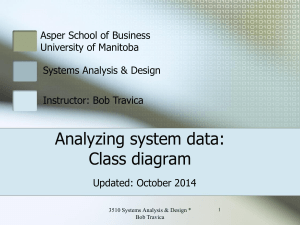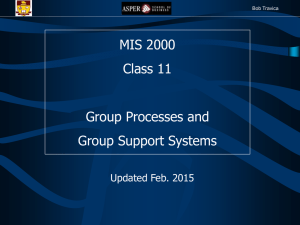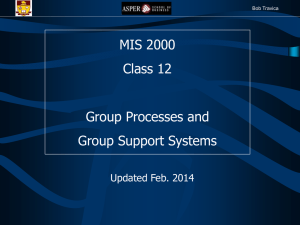Analyzing system processes: Activity Diagram
advertisement
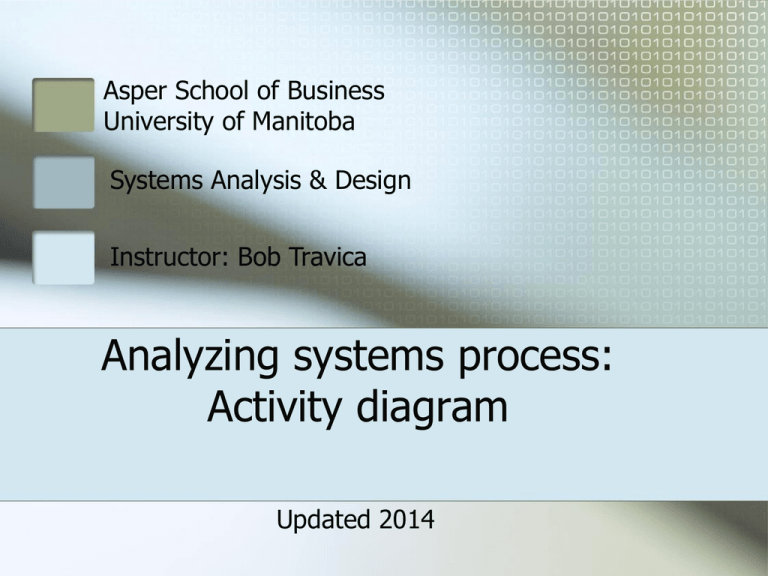
Asper School of Business University of Manitoba Systems Analysis & Design Instructor: Bob Travica Analyzing systems process: Activity diagram Updated 2014 Outline Activity diagram concept Elements of activity diagram Reading activity diagrams Process logic in activity diagram Creating activity diagrams 3510 Systems Analysis & Design * Bob Travica 2 of 12 Activity Diagram (AD) concept A diagram used for showing systems requirements; results from process analysis AD depicts: business processes (workflow) – manual & automated (carried by a system) process logic – time order of process steps (activities) & decision points actors (touch system), business event sources (initiate actors to work) AD resembles old flow charts and data flow diagram 3510 Systems Analysis & Design * Bob Travica 3 of 12 AD components – Quote Process Page 146 Start Who/What performs activity * Swimlane (column) Time approximation Activity, Process step Process flow (control) Decision point; yes/no branching Loop, one technique: decision + flow back End * System=information system; sometimes called just “computer” 3510 Systems Analysis & Design * Bob Travica 4 of 12 AD components – Parallel Steps Provide Technical Details Synchronization Bars, indicate parallel processes Parallel steps, run at the same time 3510 Systems Analysis & Design * Bob Travica 5 of 12 AD for Customer Ordering by Telephone – more components Page 227 (bit modified) Decision shown as Activity: - N outflows - Outflows named - Loop One method Note: 1. loop bars 2. enter & exit condition Pasting activities to save space 3510 Systems Analysis & Design * Bob Travica 6 of 12 Process logic Sequential (step 1, step 2, step 3…) Conditional: If-Then (decision points: if condition A, then step n); binary or N-ary choices as outflows Iteration/loop: Control back to a previous step while a certain condition persists) Slide 4, feedback from the “Change required?” decision point Slide 6, loop between bars For each item to End of each 3510 Systems Analysis & Design * Bob Travica 7 of 12 What AD does not show? Data passed between steps (Data flow diagram shows it) Objects (But can be inferred; e.g., Customer, Order, Clerk) User interface (Clerk--System connection) 3510 Systems Analysis & Design * Bob Travica 8 of 12 How to create AD 1. Identify activities (steps) of a process 2. Identify who/what performs activities (process steps) 3. Draw swimlanes 4. Identify decision points (if-then) 5. Determine if a step is in loop (For each…, or if-then loop) 6. Determine if step is parallel with some other 7. Identify order of activities, decision points Continues… 3510 Systems Analysis & Design * Bob Travica 9 of 12 How to create AD (cont.) 8. Draw the start point of the process in the swimlane of the first activity (step) 9. Draw the oval of the first activity (step) 10. Draw an arrow to the location of the second step 11. Draw subsequent steps, while inserting decision points and synchronization/loop bars where appropriate 12. Draw the end point after the last step. You can tabulate these data (see next slide). 3510 Systems Analysis & Design * Bob Travica 10 of 12 How to create AD (cont.) 1 2 3 4 5 6 8 7 Step ID Process Activity or Decision Who/What Performs Parallel Activity 1 Request quote Customer No No 2 Develop requirement notes Salesperson No Yes 1 3 Decision: Help? Salesperson Yes 2 4 Salesperson enters data Salesperson No Yes 3 5 Check requirements Technical Expert No Yes 3 6 Tech. expert enters data Technical Expert No Yes 5 7 Calculate quote System No Yes 4, 6 8 Review quote Customer No Yes 7 9 Decision: Changes? Customer No Yes 8 Accept quote as order Customer No No 9 9 10 10 - 3510 Systems Analysis & Design * Bob Travica Loop Preceding Step - 11 of 12



